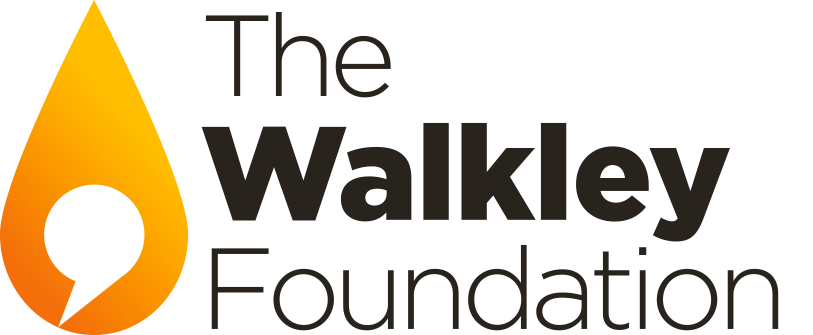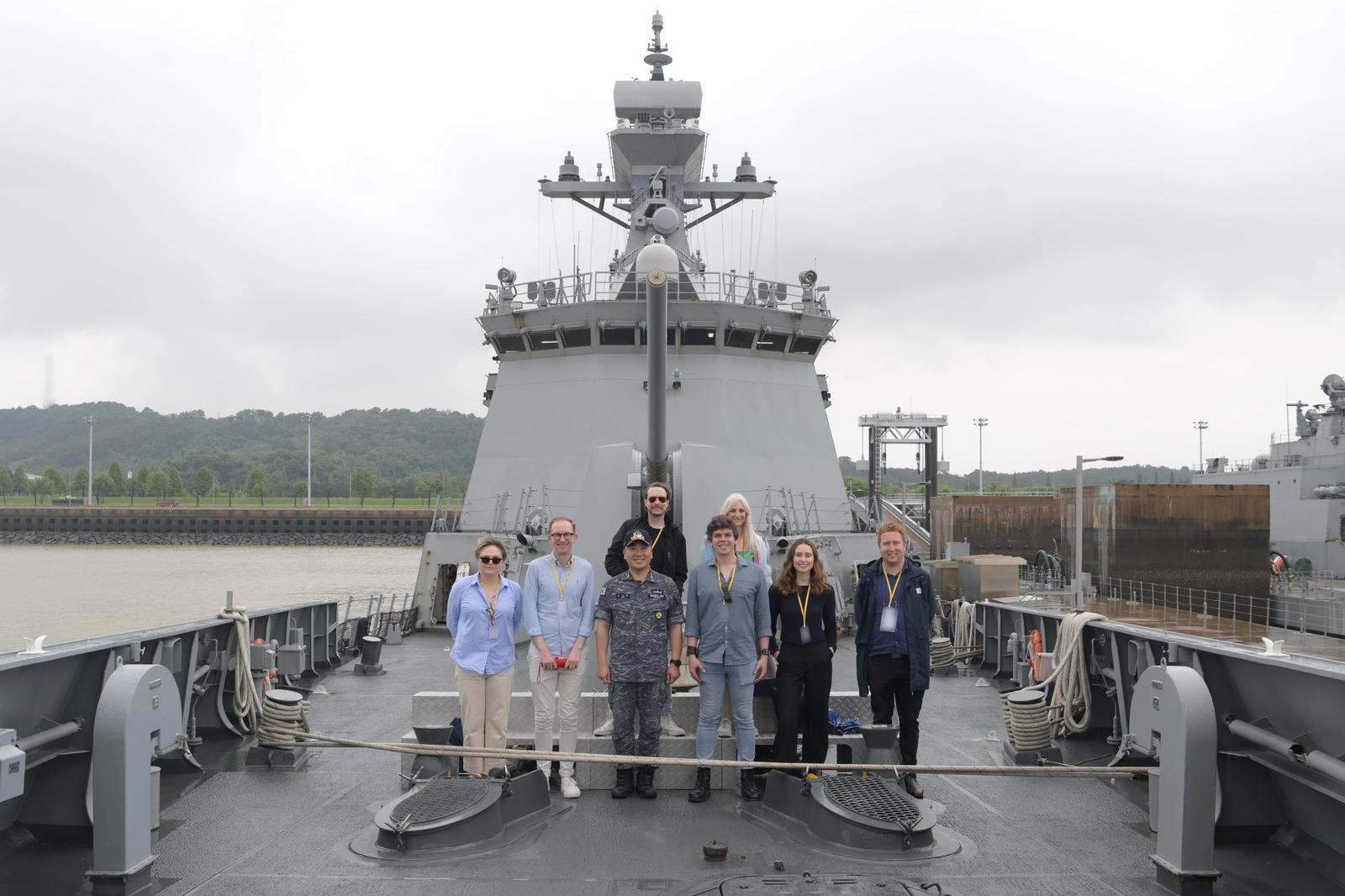James Gorman reports back on the 2024 Australia-Korea Media Exchange.
Six Australian journalists returned to Australia last week after an 11-day exchange program across the Republic of Korea (ROK). The program, supported by the Australia-Korea Foundation (AKF), the Korea Press Foundation (KPF), and the Walkley Foundation, was focused on the economic, trade, and security relationships between Australia and the ROK.
The KPF arranged a comprehensive program that took the journalists across the ROK where they had the opportunity to meet and interview South Korean businesses, key national stakeholders, defence personnel and international economic partners.
This included visits to Hanwha Aerospace, Korea Trade-Investment Promotion Agency (KOTRA), the Korean Institute of Foreign Affairs and National Security, POSCO – one of the world’s largest steelmakers, AI researchers at KAIST Research Institute, the South Korea demilitarised zone (DMZ), Pyeongtaek Navy 2nd Fleet, and US/UN military base Camp Humphreys.
Alex Blair, News.com.au; Bridget Carter, The Australian; Nadia Daly, ABC, Elouise Fowler, AFR, Tobi Loftus, ABC; and Michael Read, AFR and I travelled from Sydney to Seoul’s Incheon International Airport on Sunday 30 June to take part in the Australia-Korea Media Exchange program.
30 June
The journalist and I left Sydney together on our way to South Korea.
1 July
The program officially commenced with a background briefing at the Australian Embassy in Seoul, led by the Australian Ambassador to the ROK, Jeffrey Robinson.
The journalists then met with Dr Peter Lee from the Asan Institute for Policy Studies followed by a Q&A with the Korean Ministry of Foreign Affairs. They discussed a raft of topics from Australia-Korea trade relationships to North Korean tensions.

Australian journalists at the Australian Embassy in Seoul
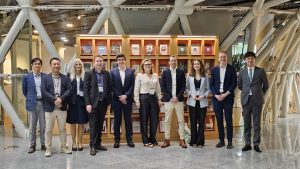
The Asan Institute for Policy Studies
2 July
The delegation started their morning meeting with the Korean Ministry of Environment. The session was an opportunity to garner an understanding of the ROK’s biggest ecological concerns, and its status as a non-nuclear nation poised a stone’s throw from its North Korean neighbour. After the Q&A, the delegation had a debriefing and lunch with our host, the Korean Press Foundation. After lunch, the delegation visited Money Today Network (MTN) where they met some of their journalistic counterparts in Korea and gained insight into the country’s media landscape. The day ended with a Q&A at the Seoul Tourism Organization, where the journalists learnt about Korea’s largest tourism competitors in the region, and what sets them apart.
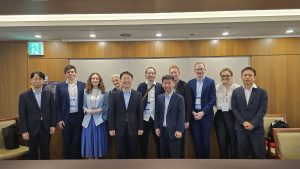
Korean Ministry of Environment
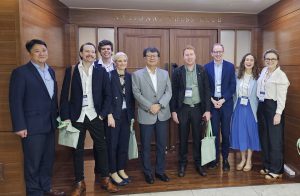
The Australian delegation with our hosts, the Korea Press Foundation

Money Today Network

Seoul Tourism Organization
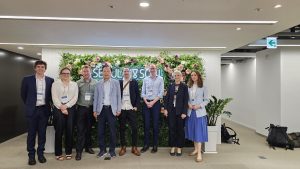
Seoul Tourism Organization
3 July
The day started with a visit to the Korea Trade-Investment Promotion Agency (KOTRA), an institution under the Ministry of Trade, Industry, and Energy, established to contribute to the development of the national economy through technology cooperation between domestic and foreign companies. After lunch, the delegation visited YTN, Korea’s largest 24-hour news network. The journalists were amazed by the scale of the media operation, which has reporters permanently based in key locations all around the globe.
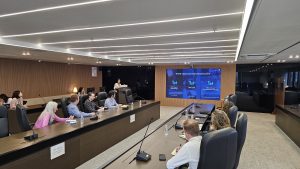
Korea Trade-Investment Promotion Agency (KOTRA)
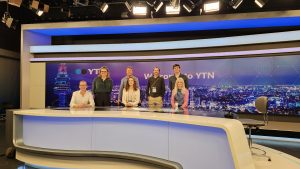
Site visit to YTN

Tobi Loftus, ABC (right) interviewing YTN reporter Sung Yoon Ri (left)
4 July
The journalists met with Australian Chamber of Commerce in Korea chairman Ross Gregory and director Rowan Petz to discuss how Australian organisations can successfully navigate the business landscape in Korea. During the meeting, Mr Petz expressed his eagerness for more Australian businesses to enter the Korean market. Following the meeting, the journalists travelled to Paju to visit the South Korean demilitarised zone. During the tour, the delegation ventured into the Third Infiltration Tunnel dug by North Koreans after the signing of the Korean War armistice as a means to surreptitiously infiltrate Seoul, and visited the Dora Observatory where the delegation could peer into the North Korean border.
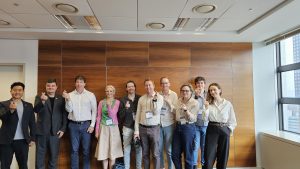
Australian Chamber of Commerce
5 July
The day started with a meeting at the Foreign Affairs and National Security (IFANS), a think-tank under the Korea National Diplomatic Academy and Ministry of Foreign Affairs. IFANS’ Seonjou Kang shared insights into Korea’s foreign relationship with Australia and the tensions between North and South Korea. Following the meeting, the delegation had a Q&A session at the Global Knowledge Exchange and Development Center (GKED) where they gained insights into Korea’s socio-economic development since the Korean War, and ways the country is addressing critical economic issues like plummeting birth rates. The journalists then visited Cheongwadae, the Blue House, the former palatial residence of the ROK President. That evening the journalists attended a dinner where they had an opportunity to meet with the cohort of journalists from Korea who visited Australia in April 2024 as part of the exchange program.
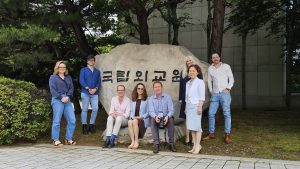
Foreign Affairs and National Security (IFANS)
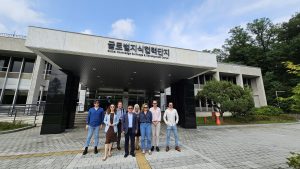
Global Knowledge Exchange and Development Center (GKED)
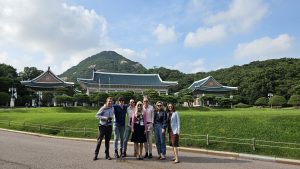
Cheongwadae, the Blue House
6 July
The journalists and I boarded a KTX bullet train where we travelled three hours south to Changwon.

7 July
The journalists were treated to a change of pace with a visit to Seongjusa Buddhism Temple (Gomjeol Bear Temple). We changed into temple training clothes and walked barefoot and in silence along the Red Clay Trail as an act of reflection. We then participated in a traditional tea ceremony.
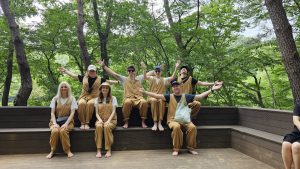
Seongjusa Temple Red Clay Trail
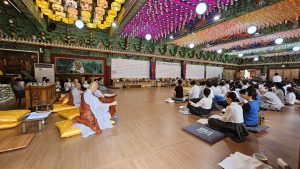
Seongjusa Buddhism Temple, Changwon
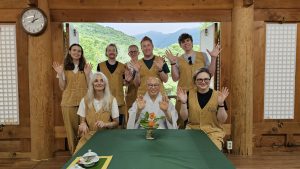
Seongjusa Buddhism Temple, Changwon
8 July
The morning started with a meeting at Hanwha Aerospace in Changwon. Hanwha recently signed a contract with Australia for 129 ‘Redback’ offensive military vehicles worth $2.4 billion. During the visit, the journalists toured the assembly yard and were treated to rides in a K9 self-propelled howitzer. (In April this year, journalists from Korea had an opportunity to visit Hanwha’s Armoured Vehicle Advanced Center in Geelong, Victoria as part of the exchange program.) The delegation then travelled to Gwangyang to visit POSCO, one of the world’s largest steel manufacturers, where they toured the site and witnessed the smelting process.
9 July
As we neared the end of our program, the journalists visited the KAIST Research Institute, a specialised university developing future technologies, including AI, haptic research and the Metaverse. The journalists participated in several demonstrations, including haptic AI, allowing users to feel sensations in their hands with a specialised glove. After lunch, the delegation travelled to Pyeongtaek to visit the Navy 2nd Fleet. We were invited onto the ROKS Seoul, Daegu-class frigate and were given a tour by the ship’s captain, Commander Je-Joon Park, before visiting Camp Humphreys, the largest US military base outside of America and home to the UN’s base of operations in the region.
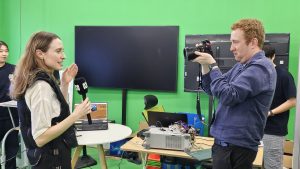
KAIST Research Institute
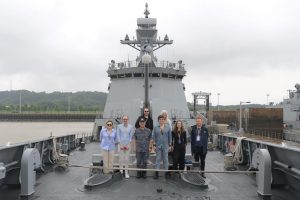
ROKS Seoul, Daegu-class frigate
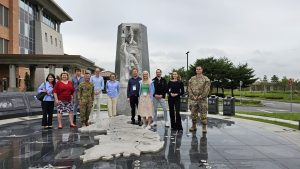
Camp Humphreys
10 July
After a busy 11-day program, the journalists attended a meeting at Hyundai’s Global R&D Center to discuss the future of shipbuilding and the development of autonomous sea freighting. With a plethora of meetings, sights and once-in-a-lifetime experiences behind us, it was time for us to make our way home to Australia.
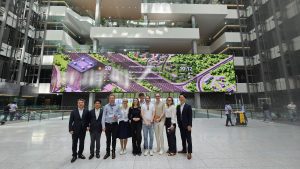
Hyundai’s Global R&D Center
The 2024 Australia-Korea Media Exchange was a unique opportunity for all attendees to garner a deep understanding of the strong economic, diplomatic and security ties between Australia and Korea. Despite working for rival media organisations, the cohort worked together as a team during the program; setting embargoes, sharing quotes, supporting each other with story ideas and creating lasting friendships. Their camaraderie showcased a dedication to their craft and highlighted the values the Walkley Foundation strives to uphold for the Australian media sector.
About the Australia-Korea Media Exchange
In 2022 the Walkley Foundation announced its continued partnership with the AKF and KPF for media exchange programs over the next three years.
The Walkley Foundation was awarded a $120,000 grant by the Department of Foreign Affairs and Trade to support the media exchanges between Australia and the ROK.
Testimonials
Nadia Daly, ABC
The exchange was a comprehensive, jam-packed and very well thought out program that gave us as reporters a rich insight into the different facets of Korean society, business and culture and really broadened our understanding of the country. We traversed the length of the country, from visits to the DMZ to high level business briefings, meetings with government officials, factory visits, meeting with executives at companies like Hyundai and POSCO, and wonderful cultural experiences like a visit to a Buddhist temple and a tour of the Blue House (Korea’s White House), the Walkley Australia Korea Media Exchange was a really valuable, highly rewarding experience and well worth our time.
Our hosts were incredibly generous and were so patient and welcoming for our week and a half trip. It was clear how much time and effort had gone into planning the visit and ensuring we got the most out of it. They planned full schedules for each day with a range of meetings and activities and introduced us to the most incredible local food and culture in between our briefings and meetings.
I would highly recommend this program to any journalist wishing to get greater insight into Korea and to make great contacts in business, government, media and think tanks.
Tobi Loftus, ABC
It is often said that the highlight of a journey is the people you meet along the way, and while cliché, that rings true for the Walkley Foundation’s Australia-Korea Media Exchange.
Over the 10 days, we met many government and industry stakeholders, as well as ordinary people, who went above and beyond to open up to us about South Korea, how it works and provide their thoughts and insights on a range of issues.
Professionally, it was an extremely valuable experience, providing context and insight into a part of the world often at the centre of international headlines.
Personally, it was the opportunity of a lifetime to explore another country in this way and work with some of Australia’s best reporters from across multiple organisations. Meeting and speaking with reporters from across Korea was also highly valuable. Our joint passion for the news, in all its forms, was infectious.
I urge any reporter across Australia to apply for this exchange in the future.
And yes, we ate A LOT of kimchi.
Bridget Carter, The Australian
The Walkley Foundation and Korea Press Foundation media exchange was highly beneficial to my journalism.
I came away with such a different perspective on both South Korea and Australia and the importance of the relationship between the two countries from a strategic perspective.
The trip was very well organised. Our Korean guides were excellent and a highlight was definitely the visit to the world’s largest steel mill owned by Posco.
Speaking to journalists at other media organisations is something I also found particularly useful and I gained an insight into how the industry operates there compared to here in Australia.
It also provided the opportunity to make good contacts, meet some great local journalists who had fascinating stories to tell about their coverage across the border in North Korea, and come back with a notebook full of ideas for future articles.
The trip is well worth it for any Australian journalist.
I feel it has given me a competitive advantage with respect to covering matters touching on South Korea in the future.
Michael Read, AFR
The Walkley Foundation and Korea Press Foundation media exchange was highly beneficial to my journalism.
I came away with such a different perspective on both South Korea and Australia and the importance of the relationship between the two countries from a strategic perspective.
The trip was very well organised. Our Korean guides were excellent and a highlight was definitely the visit to the world’s largest steel mill owned by Posco.
Speaking to journalists at other media organisations is something I also found particularly useful and I gained an insight into how the industry operates there compared to here in Australia.
It also provided the opportunity to make good contacts, meet some great local journalists who had fascinating stories to tell about their coverage across the border in North Korea, and come back with a notebook full of ideas for future articles.
The trip is well worth it for any Australian journalist.
I feel it has given me a competitive advantage with respect to covering matters touching on South Korea in the future.
Alex Blair, News.com.au
The media exchange program to South Korea offered an invaluable experience that was fascinating to report on. From the DMZ to Buddhist temples, a wide variety of topics were covered.
Meetings with everyone from ambassadors, business leaders, politicians, Buddhist monks and fellow journalists gave every single person on the trip something to sink their teeth into back in Australia. It was great to travel and work closely with some of Australia’s best reporters and develop friendships over the packed 11-day schedule.
Our hosts were highly professional and extremely friendly, making our journey through the country a breeze.
I highly recommend any Australian journalist interested in foreign affairs to apply for this trip.
Elouise Fowler, AFR
Spending nearly two weeks observing a society and economy perpetually preparing for war with its northern neighbour amidst a fracturing global trading system and geopolitical upheaval was an immensely valuable experience.
The fellowship program involved traversing the country for meetings with decision-makers in Seoul, visiting the Demilitarised Zone, and touring Korea’s provincial industrial heartland. In Seoul, we interviewed government officials and analysts to explore issues of trade, security, and defence.
We then travelled 300 kilometres south to meet with one of Australia’s largest iron ore and coal customers, the Posco steelworks in Gwangyang. Not far from there, we visited an arms manufacturer that uses Posco’s steel to build tanks that Australia has agreed to buy. Looping back north toward Seoul, we visited Camp Humphreys, the largest overseas US military base, and a Korean naval base, whose crew had visited Australia for joint naval exercises. I wholeheartedly recommend this fellowship to anyone seeking a deeper understanding of Australia’s third-largest trading partner and our region.
